This article discusses the concept of fusion reality, where technologies like AR, VR and the IoT converge.
Augmented reality (AR) and virtual reality (VR) technologies are rapidly evolving. Improvements to these technologies are, in turn, improving the virtual world user experience, enabling users to do things that have not been possible before.
VR technology allows users to enter the virtual world and interact with virtual things. It is not limited to gaming—other application areas include enhancement of the education system, enablement of doctors to remotely handle surgeries, and contribution to industrial manufacturing processes and quality control, among others.
In addition, AR and VR create opportunities to connect augmented/virtual displays to online platforms for sharing the views of AR/VR users. AR enables viewing virtual information overlaid on the real world.
A company called PTC (Boston, USA) has developed a software application called Vuforia, which provides a platform to combine Internet of Things (IoT) with AR. It allows developers to connect IoT devices with AR applications to augment real objects with a virtual display showing additional useful information, such as real-time data streams.
In the medical field, VR and AR technologies are being implemented to enhance and develop advanced health services. The virtual world is based on enabling technologies that go beyond the boundaries of the categorised world, in a concept called fusion reality.
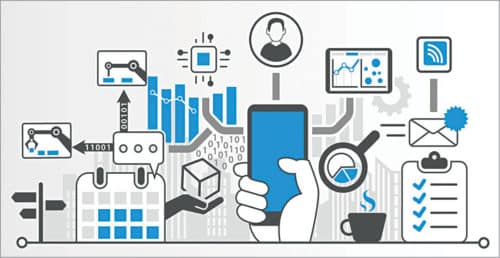
Fusion reality is a combination of different virtualisation technologies, such as VR, AR and the IoT. Currently, IoT technologies have transformed many industries in different countries, based on the country’s policies. Recently, the German government started a project called Industry 4.0, which aims to improve industrial processes with the help of IoT technologies.
General Electric has a similar project named Industrial Internet. Such projects are expected to boost the revenues of these companies.
Industry 4.0 technologies transforming industrial growth and production
Industry 4.0 refers to a new industrial technology era that is transforming current systems, sensors, machines and workloads. It can help create more efficient processes using the nine pillars of technology: cyber security, AR, big data, autonomous robots, additive manufacturing, simulation, system integration, cloud computing and the IoT (Fig. 2).
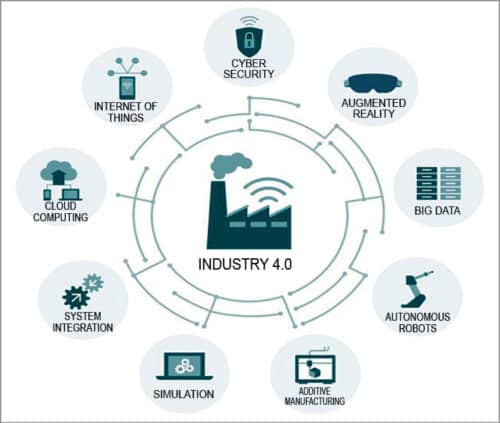
Cyber security
Due to demand for better Internet connectivity and communication protocols in Industry 4.0, there is a need to secure and protect industrial data processing systems from hackers and other cyber security threats. Reliable and sophisticated communication protocols help maintain secure communication between electronic devices.
Augmented reality
Playing a vital role in Industry 4.0, AR helps select manufacturing parts and send industrial fault status information to applications installed on users’ phones. Many companies are developing applications to provide real-time information about product processing to workers. They are also making smart applications that help with decision making and improved work procedures.
Big data
In Industry 4.0, collection and analysis of data from different sources is a major problem. Big data can help optimise data, production quality, save energy and improve services. The main goal is to allow real-time decision making.
Autonomous robots
These robots handle complex tasks that are difficult for human beings, by interacting with one another and with humans. These also reduce setup times and quality.
Additive manufacturing
In Industry 4.0, companies are adopting 3D printing technology for manufacturing and prototyping of products. 3D printing helps produce small batches of customised, high-performance products. This reduces transportation and management costs.
Simulation
3D simulation is used in plant operations to monitor and analyse real-time data and create a mirror image of the physical world in a virtual model. This includes machines, products, sensors and humans. It helps drive down machine setup time and improve quality.
System integration
These days, information systems are not fully connected and integrated. Suppliers and customers are not synchronised with an organisation. In Industry 4.0, the whole organisation is inter- and intra-connected with each other.
Cloud computing
Industry 4.0 requires more data, storage and data sharing across machines and data-limited boundaries. With advanced cloud computing, more machines and servers are deployed on the cloud. This helps attain better results and provide visibility to the entire supply chain.
The IoT
The IoT is defined as a combination of networks that enables dual communication between machinery, facilities, finished and unfinished products via local intelligence. It incorporates deep learning and machine learning, big data, industrial data sensors, machine-to-machine communication and more. Results, when compared to humans, are more accurate and reliable.
Applications of IoT and AR in Industry 4.0
Complex assembly
There are thousands of components that require expert skill-sets and instructions. A combination of the IoT and AR provides a solution for Industry 4.0. Recently, Volvo experimented with AR on its assembly line using Microsoft HoloLens (Fig. 3).
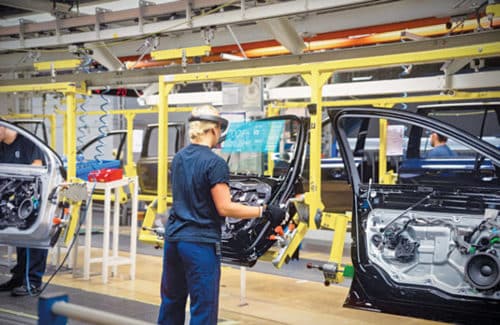
Maintenance
In addition to assembly line, AR and the IoT also improve the way maintenance is carried out. Mitsubishi developed an AR-based 3D software for maintenance, that enables order inspection on AR display and shows the results with voice instructions.
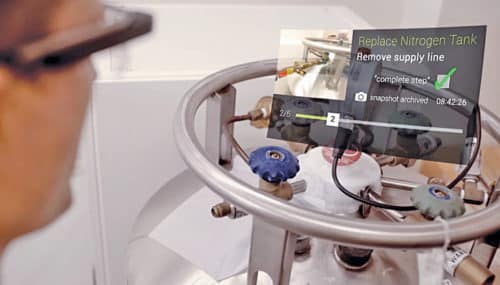
Expert support
Manufacturers need to provide services for machines. To do so, they sometimes spend a lot of time and money travelling to the destination of the machine. Telepresence is a great solution for manufacturers to provide services virtually, where experts can look through the eyes of technicians (Fig. 5).
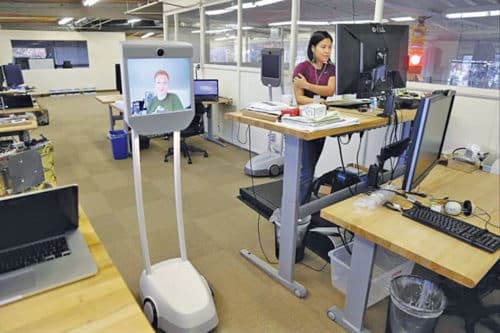
Quality assurance
AR helps improve quality assurance of the industry. Recently, Porsche, Germany ran a pilot program where technicians used AR and the IoT as tools for quality assurance (Fig. 6).
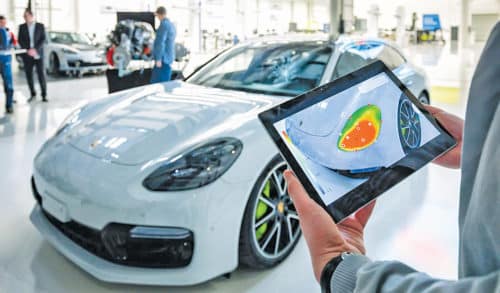
Companies supporting AR and the IoT
1. AstralAR drones use a combination of the IoT and AR. These fly using the user’s mental commands and integrate a neuromechanical interface.
2. Lampix is a hardware and software solution that can turn any surface into a smart augmented surface (Fig. 7). It uses image recognition, machine learning and sensors that help transform the existing horizontal surface into an interactive one. This platform was created using a simple graphics interface that can be very helpful for developers from a learning point of view.

3. NUVIZ is an AR-enabled helmet for motorbikes (Fig. 8). It incorporates many technological functions into one helmet, including music, action camera, navigation and communication with least noise, to allow the rider to focus on the road. The company believes in the journey being more enjoyable and efficient at the same time.
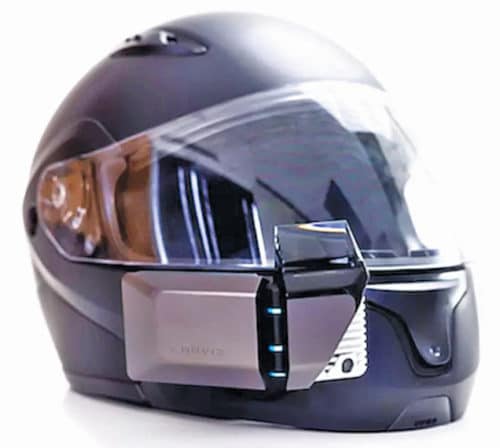
4. Titanium Falcon introduced a gesture and touch-sensitive controller in the form of a ring (Fig. 9). The wearable ring enables IoT applications such as switching the lights on and/or off, AR/VR gaming and flying drones.
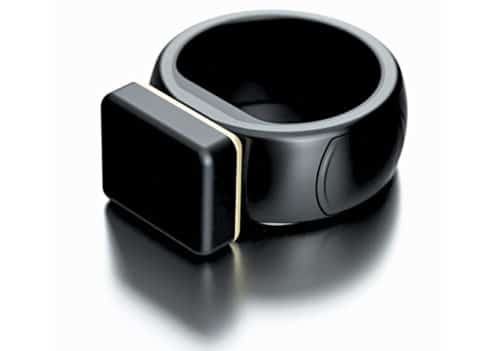
LyteShot is an IoT- and AR-based gaming platform that encourages users to play real-time action games (Fig. 10). It uses both hardware and software platforms to integrate and simulate games and players using 3D models.
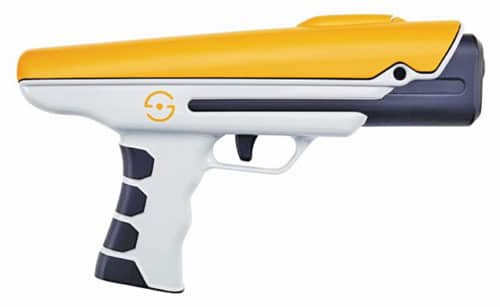
Vikram Puri is researcher in R&D Center of Visualization and Simulation, Duy Tan University, Vietnam
Dr Jolanda G. Tromp is director, R&D Center of Virtualization & Simulation, Duy Tan University, Vietnam
Chung Van Le is vice director, R&D Center of Virtualization & Simulation, Duy Tan University, Vietnam








